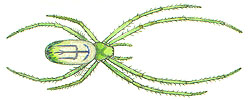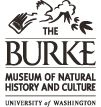 |
|
| You Are Here: Burke Museum : Spider Myths : "Dangerous" : What bit? |
Myths about "Dangerous" Spiders
Myth: Doctors can always tell what spider bit you from the bite alone.
Fact: If they could, there wouldn't be hundreds
of cases annually mis-diagnosed as "brown recluse
bite" in regions where the spiders being blamed don't exist.
There are so many possible causes of bite-like sores that even an expert on
venoms and arthropod bites can't always be sure of the cause in a particular
case. One such expert, the late Darwin
Vest, has been a missing person, presumed dead, since June 1999. Medical students don't even get one full day's training in spider-related topics. Researchers
in Colorado and Michigan have developed techniques to diagnose bites by biochemical
lab work, but currently few labs offer this service, which only works if done within a week after the bite
occurs. I myself am often asked to advise people with "mystery bites"
but I can't; my specialty is spiders, not bitten humans.
The moral of this is, if you see a spider bite you (an event of once-in-a-lifetime
rarity), or any other biting or stinging creature for that matter, save the
specimen for an arachnologist (and only an arachnologist!) to examine.
Don't give it to someone who knows nothing
about spiders.
Myth: Spiders carry germs on their fangs that can cause infection.
Fact: There is still no solid evidence of any
spider causing an infection in human tissues by its bite. However, since this
section was first written, a study by C.L.B. Monteiro and others of the Brazilian
recluse spider Loxosceles intermedia found bacteria, including the gangrene-causing
Clostridium perfringens, on the fangs of 36% of the spiders studied and
16% of venom samples passed through the fangs, though venom taken direct from
the venom glands was sterile. These results have yet to be repeated with any
North American spider. Recent research by J. Sandidge suggested that Loxosceles reclusa (the brown
recluse of south-central USA) prefers already-dead insects to prey it kills
itself, being in fact the first known case of a habitual scavenger spider. This
would greatly increase the chance of recluse spiders' fangs being contaminated,
compared to other spiders. However, the scavenging conclusion was recently questioned.
Recluse spiders are not found in most areas, and there is no reason to think
a typical spider could cause infection by its bite. A 2006 study found potentially infectious microbes on only one of 100 house spiders tested. To be sure, a spider bite
punctures the skin and the punctures could become infected later. To prevent
this, simply disinfect it the same way you would disinfect any scratch or puncture.
Many uninformed physicians routinely treat the open sores caused by recluse spider bites as if they were infections, and give the patients antibiotics.
The effect of these bites is not caused by infection, but by the venom
directly attacking the tiny blood vessels in the tissue. In true spider bite
cases, antibiotics are generally worthless, and real bite victims being so treated
would be well advised to seek doctors who know more about their condition. However,
the Monteiro results mentioned above suggest that unusually severe spider bite
lesions should be tested for Clostridium, and if positive, treated with
appropriate antibiotics.
| Previous Myth | Myths Home | Web Resources | Next Myth |
 |
Text ©
2003-2010, Burke Museum of Natural History & Culture, University of Washington, Box 353010, Seattle, WA 98195, USA Phone: 206-543-5590 Photos © as credited |
Queries
to Spider Myths author, Rod Crawford This page last updated 1 September, 2010 This site best viewed at 800 x 600 using IE 5.0 or above. |